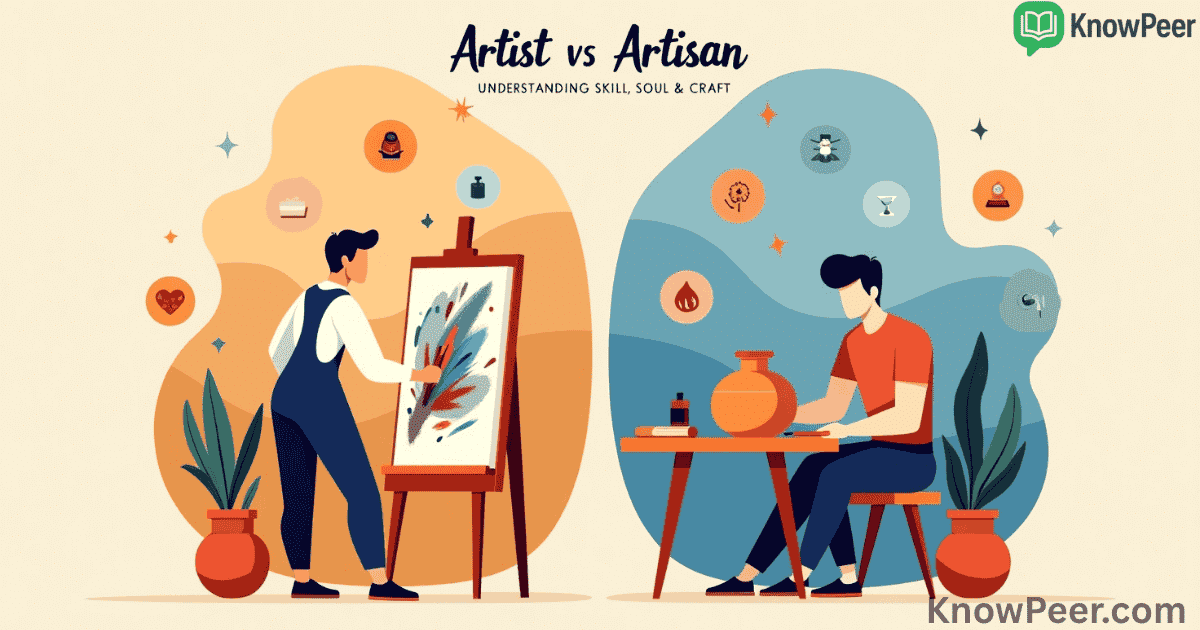Introduction
The difference between an artist and an artisan has always sparked curiosity. These two words sound similar, but they speak to different worlds Artist vs Artisan. In today’s creative economy, it’s even more important to know how they are different. People who create for passion or profession often wonder where they belong—artist or artisan?
Many think these terms mean the same thing. But they do not. An artist is often seen as a dreamer, someone who creates with no rules. An artisan is someone who builds with care, focusing on skill and detail. Both are creators. Yet their purpose, methods, and results can be very different. Let’s explore this journey of imagination and craftsmanship.
What Makes an Artist, What Makes an Artisan?
An artist is someone who uses imagination to create something new. The work can be emotional, abstract, or filled with personal meaning. Artists often work in painting, sculpture, writing, or music. Their goal is to express a feeling or idea.
An artisan, on the other hand, creates items with function and beauty. Their work is skilled, often passed down from past generations. You will find artisans in pottery, leatherwork, weaving, and woodworking. The goal is to make something useful and well-crafted.
| Feature | Artist | Artisan |
| Main Goal | Expression, emotion | Function, quality |
| Work Type | Painting, music, poetry | Pottery, weaving, metalwork |
| Method | Freeform, unique | Repeated, detailed |
| Recognition | Galleries, museums | Markets, trade, communities |
The Evolution of Roles: From Guilds to Galleries
In the past, artisans were part of guilds. They made shoes, swords, furniture, and more. These skilled makers trained for years, often learning from family or masters. Their creations served everyday life. People respected their work because it was useful and lasting.
Artists, however, were once seen as craftspeople too. But during the Renaissance, that changed. Art began to be seen as a noble calling, full of emotion and creativity. Painters like Michelangelo and Leonardo da Vinci became known not just as workers but as visionaries. Over time, the artist was lifted above the role of a mere worker. Their role became more about thought, message, and vision.
Philosophical Divide: Art for Emotion, Craft for Function?
Many believe that the true difference lies in purpose. Art exists to make you feel, think, or reflect. It asks questions and may not offer clear answers. It is emotional and open to interpretation.
Craft, on the other hand, is about perfection and repeatable skill. A crafted bowl or chair serves a clear purpose. It may be beautiful, but it is made to be used. Philosopher John Ruskin once said that “art is the expression of society,” while craft is its structure. This highlights how the artist aims to stir the heart, while the artisan works to serve the hand.
Key Differences: Artist vs Artisan Side-by-Side

When comparing an artist and artisan, there are some clear differences. The artist wants to share a feeling. The artisan wants to share a finished product. Artists create things that are often one-of-a-kind. Artisans create things that may look alike but are still made with care.
Here is a simple table to see the differences:
| Aspect | Artist | Artisan |
| Purpose | Express ideas | Create functional beauty |
| Style | Often abstract | Often detailed |
| Method | Improvised | Structured |
| Tools | Brushes, pens, digital tools | Chisels, looms, carving tools |
| Outcome | Emotional response | Usable product |
The Grey Area: When Art and Craft Intersect
Some people do not fit neatly into one category. Many creators mix both worlds. For example, a woodworker may carve a cabinet that also tells a story. A jewelry designer might create pieces that are as expressive as a painting.
These creators blend emotion with function. Their work is both useful and meaningful. Fashion designers, tattoo artists, and ceramicists often live in this space. Their work uses artistic vision and artisanal technique together.
Etymology and Linguistic Roots: What the Words Tell Us
The word “artist” comes from the Latin “ars,” meaning skill or craft. Over time, this word became linked with fine arts like painting and music. The word began to represent someone who creates for beauty, not function.
The word “artisan” comes from the Latin “artitus” and Italian “artigiano,” meaning one who builds or makes. This reflects the hands-on nature of the artisan. It also shows their work was meant to last, be used, and serve a purpose.
Cultural Variations: Artist vs Artisan Across the Globe
Different cultures do not always see a clear split between these terms. In Japan, a shokunin is a master of craft, but their work is also full of heart and pride. In India, karigars create stunning embroidery, metalwork, and stone art. They are artisans by trade, but their work is full of soul and design Artist vs Artisan.
In Africa, guilds still pass down skills across generations. The line between art and craft is thin. These makers may never call themselves artists, yet their work is praised in museums around the world. In each region, the value of the work matters more than the title.
Education & Training: Learned vs Inherited Skillsets
Many artists attend art schools, universities, or take online courses to study fine art. They learn history, theory, and technique. Their education is often formal. They are encouraged to explore, question, and create.
Artisans usually learn through apprenticeship or family tradition. They practice the same skill for years. Precision and patience are key. Some also attend trade schools. Their focus is on mastery of the material, not just the idea behind it.
Tools of the Trade: Brushes vs Blades
Artists use a wide range of tools, including paintbrushes, charcoal, tablets, or musical instruments. Their tools are meant for expression. The final piece may be abstract or emotional.
Artisans, however, use tools built for precision. Think of a weaver’s loom, a potter’s wheel, or a blacksmith’s hammer. These tools help them make something strong and lasting. The tools they choose show their level of skill and the care in their craft.
Recognition & Value: Markets, Prestige, and Pay
Artists often get recognition through galleries, museums, and exhibitions. Their success may depend on critics, curators, and art collectors. Prices vary widely. One artist’s painting could sell for thousands, while another may struggle to sell one.
Artisans gain recognition in craft fairs, small shops, and online markets. Their products may not fetch high prices, but they sell more frequently. Their work is often seen in homes, fashion, or everyday items. Both careers face challenges. Yet both offer value in beauty, tradition, and culture.
Technology’s Role: AI, Digital Art & CNC Machines
Today, technology plays a big role in creative fields. Artists now use AI to generate images, write poems, or even compose music. Digital tablets have replaced canvas for many modern artists. New tools bring new ideas.
Artisans use machines like CNC routers, laser cutters, and 3D printers. These help them scale their work, yet they still need deep skill to use. Technology does not erase the human touch; it often adds to it. The line between artist and artisan becomes even more blurred.
Case Studies: Real People Bridging the Divide
Alice Rawsthorn, a design critic, often talks about how boundaries between art and craft are fading. Consider George Nakashima, a woodworker whose chairs are also seen as fine art. His work blends functionality with spiritual design.
Another example is Junya Ishigami, an architect whose buildings look like sculptures. He treats structure as both artistic form and practical space. Lastly, El Anatsui, a Ghanaian artist, creates wall hangings from bottle caps—part sculpture, part textile art. Each case shows that labels can’t contain creativity.
Social and Economic Impact: Artisan Economies vs Art Industries

Artisan economies thrive in local settings. Handwoven baskets, handmade clothes, and carved tools provide income for families and communities. Countries like Mexico, Morocco, and India support whole towns through artisan markets.
The art industry, on the other hand, is global. A painting can be sold in New York and seen online worldwide. Artists make money through galleries, NFTs, and licensing. Each space has its own rules, but both are part of the creative economy.
Criticism and Validation: Who Decides What’s Art?
Who says what is art or craft? Often, critics, curators, and even buyers hold that power. An object in a museum becomes “art” by choice, not just by form Artist vs Artisan. A handmade item in a market may never be seen as “fine art,” even if it took more skill.
This power dynamic is shifting. Social media lets people show their work without middlemen. Now anyone can be an artist or artisan with the right audience. The gatekeepers are not as strong as before.
Quiz Section (Interactive): Are You More Artist or Artisan?
Think about these:
Do you prefer to follow patterns and perfect a skill? Do you like to work with tools or with ideas? Your answers may reveal if you lean more toward artist or artisan.
Many people fall in between. And that’s okay. Creativity is not a box. It’s a wide field where everyone can find their place.
Final Thoughts
Rather than choosing sides, we should see the artist and artisan as part of one big story. Both give us beauty, skill, emotion, and meaning. They just take different roads to get there.
Let us value the hands that build and the hearts that dream. The world needs both. Whether you paint, carve, weave, or design—you are part of the creative world. And that world is richer because of you.










